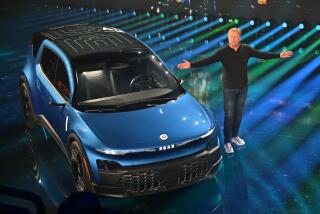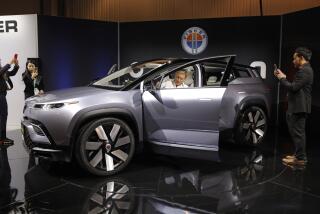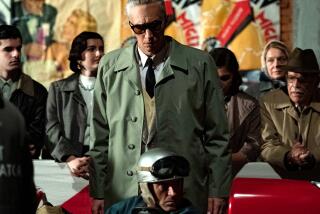A Real Money Machine
- Share via
Skeets Dunn, a San Diego municipal bonds dealer, has invested in a transportation commodity usually tied to instant depreciation and limited futures.
He bought a new car. Without a factory cash back.
He also waited three years and paid $400,000 for a two-seater that comes without carpets, spare tire, radio or safe hands willing to insure it.
This car does 12 miles per gallon in city traffic and 200 m.p.h. wherever there is that much room to run. There are hand cranks for the windows and pull cables to unlatch the doors. It is noisy, hot, jiggly, cramped, low, primal and made from the same tough, unchewable Kevlar used for Batman’s body armor.
But no dealer, collector car investor or museum curator is questioning the Wall Street wisdom of Skeets Dunn--purchaser of the first Ferrari F40 super car sold in California. Especially when, only hours after this week’s deliveries, the car began attracting premiums of up to $1 million over sticker.
Dunn, 46, of Rancho Santa Fe, a collector and restorer of classic Ferraris, began negotiating for his car in 1987 when the estimated price was only $240,000. He signed a contract with Ferrari that guaranteed he would pay only sticker price for the car.
He has yet to take delivery of his F40 from Cornes Motors of San Diego. But his phone hasn’t stopped ringing, he said, with offers of $600,000 above what he paid for the car.
“Speculation is rampant,” he said, “but I’m not selling. It’s a silly car at an absurd price, especially in today’s topsy-turvy economy. But it’s also irresistible.
“My reasoning was purely from a (Ferrari) collector’s standpoint. To do (restore) a car these days, from the ground up to concours and Pebble Beach (show) standards, the price is approaching $100,000. I thought this time, I’ll start with a new automobile and just keep it forever.”
Eight of the F40s--literally street-legal race cars with turn signals and air conditioning--arrived in the United States last week. Four were air-freighted by Alitalia from Italy to the West Coast, then delivered to dealers in Hollywood, Woodland Hills, San Diego and Newport Beach. Four more F40s were delivered to New York.
That’s it for the first dribble. A few more are on their way, and by year’s end, said a spokesman for Ferrari of North America, maybe all 40 U.S. dealers will have received one F40.
Maybe.
Only 1,000 cars will be built. More or less. Only 250 will be sold in this country. Or thereabouts. From such rarity--especially when combined with Ferrari’s mystique and heritage--comes heady, wheeling and dealing in the lightning lane of $1-million motor cars.
The F40 drips superlatives. Fastest production car in the world. The most expensive ever, anywhere. It also represents the broadest profit levels since corrective dentistry.
Dunn, with his head for business figures, recognizes and is mightily impressed by what Ferrari will earn from F40 production.
“I estimate the car costs $125,000 to build,” he explained. “It sells to dealers for $325,000. That’s a profit to Ferrari of around $200,000 per car. So on 1,000 cars, Ferrari’s profit will be $200 million. Incredible.”
Dunn believes there will be buyers even if Ferrari doubles its planned production run of the car.
“We’ve bought the next F40,” announced Rick Cole. The collective noun refers to Cole and the Marty Yacoobians, Sr. and Jr., partners in Rick Cole Auctions. “Ours will likely be in the next wave . . . but I’m not really allowed to talk about it.”
He did say the car was purchased for “seven figures plus,” and Cole wants to “be the first to auction one in this country.” Why? “Because it is a piece of art that Enzo Ferrari designed to celebrate the 40th year of his company.”
But $399,000 going on $1.4 million for something that doesn’t even have a guest room and fireplace? “Sure,” Cole said. “Because of its wonderfulness. It’s art. Some guys like tires and wheels and Ferrari. Others like canvas and Andy Warhol.”
The F40 accelerates from zero to 60 m.p.h. in the time it takes to read this sentence. Or about four seconds.
The engine is a three-liter, twin-turbocharged V-8 producing 500 horsepower. Indianapolis race engines are limited to one turbocharger.
The car is made from carbon fiber, Kevlar and aluminum and is about the weight of a Ford Escort. That’s Formula One racing technology to give the car the same power-to-weight ratio of the world’s fastest street motorcycles.
Yet the F40 meets California emissions standards. It also conforms to federal crash standards. Ferrari earned that U.S. blessing the hard way--by driving four F40s into a wall and wrecking them.
“In Los Angeles, it might not be advisable to drive an F40 to the supermarket,” said Guiseppe Greco, president of Ferrari of North America. “But I have been acquainted with people in Europe who drive their F40s almost daily, and one owner has about 14,000 kilometers on his.”
The parts of the car, Greco acknowledged, aren’t the stuff of design breakthroughs and engineering masterpieces.
But the sum.
Ahhhh!
“The engine is basically a 32-valve, eight-cylinder bi-turbo, but so what?” he explained. “You have an exceedingly powerful engine and an extremely beautiful body and that’s OK.
“But it’s the package that makes this an unusual car . . . and the incredibly high level of the materiel technology.”
Greco recognizes four categories of F40 buyer.
* The small syndicate of wealthy weekend racers who will buy one to campaign at club events.
* Investors who have scant appreciation for cars but have seen Ferrari prices rise to the level of Beverly Hills real estate and higher.
* Collectors and owners of museums, private and public.
* The heavy-footed and richly heeled who will buy an F40 as a ninth car and, on lonely nights along deserted highways, venture forth to play.
Newport Imports of Newport Beach reports a waiting list of “a dozen or more,” and there apparently is no shortage of Southern California buyers for the F40.
How to sell it seems to be the problem.
“This is a new experience for us,” said Stan Ogner, president of Ogner Motor Cars of Woodland Hills. He does not want to start a bidding war among his customers. Nor does he want to enrage longtime customers by setting a seven-figure price.
“So I will let the market set the price,” Ogner said. “I’m not going to sell the car right away because I think people will want to see it.”
Where they can see it, however, is between the people and Ogner. He said he has removed the car to a location away from the dealership “for security . . . we just don’t want people all over the car.”
Owen Ward, a Ferrari salesman for Cornes Motors, said showroom traffic “has gone up 500%” since the F40 arrived Friday. He has driven the car, of course, and gone snarling past the fences of Miramar Naval Air Station, site of the school for Top Gun fighter pilots.
“It’s kinda fun to drive it by Miramar just as an F-14 flies overhead,” he said. “You can feel the kinship.”
Cris Vandagriff, general manager of Hollywood Sport Cars, shook officials when he arrived at Ferrari’s Orange County warehouse to take delivery of an F40 for his dealership.
Toscan Bennett, Ferrari’s Western area manager, was expecting a transporter. Vandagriff said he would drive the car back to Hollywood--through the morning commute on the San Gabriel, Santa Ana and Hollywood freeways.
The journey--tooling comfortably in fourth or fifth gear and mingling smoothly with both daring and dawdling traffic--was close to a hero’s passage.
A man on a motorcycle, riding forward but staring backward, flashed the car a high sign. Youngsters flew from one side of a school bus to the other as the F40 growled alongside. A woman in a Chevrolet Cavalier looked hard, smiled, frowned and then genuflected.
Vandagriff said he is another dealer who will not immediately sell the super car. “Let the public see it,” he said. “I’m a fanatic about them. If they (cars) are locked up, the mystique will go away and people won’t aspire to have a Ferrari.”
With demand setting a market value 400% higher than its purchase price, the F40 is a born but exorbitant exemplar of the freest of economies. Personal profiteering, however, does not offend Ferrari’s Greco. He sees no need, no legal way even, of keeping the car’s price closer to sticker levels.
“As my grandfather always used to say, ‘If you can’t do anything about something, why worry about it?’ ”






